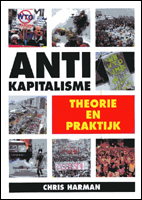
Anti-Kapitalisme:
Theorie en Praktijk
Chris Harman & Bart Griffioen
71 pages
published in 2002
Anti-kapitalisme: Theorie en Praktijk is a short book (pamphlet even) which intends to explore and explain the anticapitalist movement from a traditional Socialist (even Trotskyist) point of view. The main part of the book is a translation of an article Chris Harman wrote in September 2000 for International Socialism, the Marxist theoretical journal of the British Socialist Workers Party (SWP), perhaps the most important truely Socialist political party existing in the United Kingdom today. The SWP has branches or affliated organisations all over the world, with the Netherlands being represented by the Internationale Socialisten, who published this book. One of their more prominent members, Bart Griffioen, provided an afterword, updating the main article to take into account the momentous developments since its original publication.
The anticapitalist movement first became widely known due to the protests against the World Trade Organisation held in Seattle in 1999, where it became clear a new, radical, worldwide mass movement had been born. This movement had actually been around for years if not decades at that point, but Seattle was where it all came together. In Seattle, several very different organisations and groups worked together for the first time, each arriving at their anti-capitalist stance through a different route: environmentalists, trade unions, socialists, anarchists, activists from developing countries, people working on debt relief, etc. etc.
It seemed unbelievable that ten years after the Berlin Wall came down, ten years after the "thriumph" of capitalism over what it called socialism, at the tail end of a decade in which all mainstream political groups had more or less willingly accepted the logic of neoliberalism and globalisation, there once again was a mass movement of people who did not accept the received wisdom that capitalism was the only game in town. Yet there it was.
Anti-kapitalisme: Theorie en Praktijk tries to explain where this movement came from, what it is protesting against and how this movement should evolve. Chris Harman does this from a traditional socialist point of view, but without any hint of rote Marxism. He lays bare both the strengths and the flaws of the movement, showing where the various groups and alliances within it are right and wrong in their views, quoting liberally where needed.
Not surprisingly, Harman pleads for a more organised movement, arguing that the decentralised nature of the anticapitalist movement and its flexibility may be what gives it its strength now, but that if the movement wants to move forward and provide a real challenge to the status quo, it needs to organise and agree on a direction. According to Harman, there should of course be space for a thousand flowers blooming, but that at some point these ideas need to be evaluated; there needs to be a direction to the movement will it succeed.
Also not surprisingly, he argues for this direction to be a socialist one and rejects those who would want to come to some agreement with the powers that be. He is especially outspoken about accepting partial solutions, arguing that e.g. debt reducement for developing countries is a worthwhile short term goal, but that without drastic changes, this will only be a temporary easement. As long as the capitalist system is unchanged, these problems will recurr, is the central point of this book.
